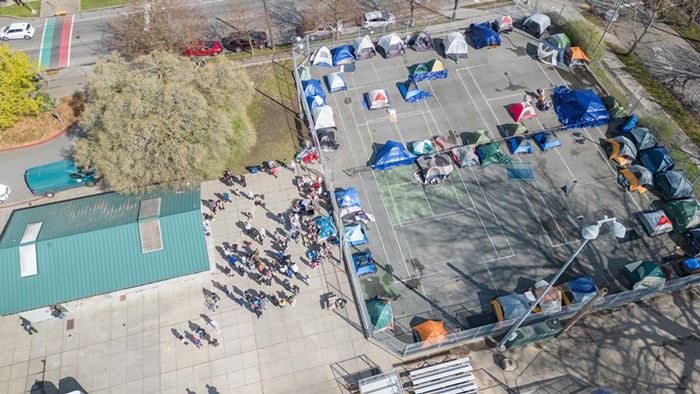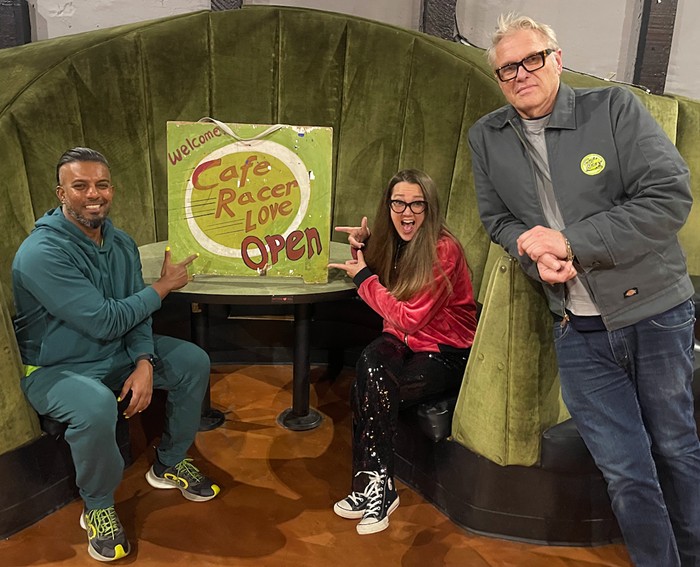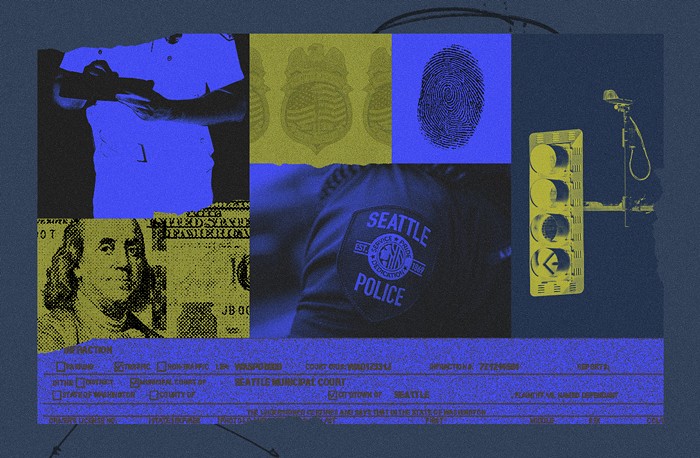Seattle photographer Charles Peterson's postcards from punk's edge immediately transport you into performances that, in real time, flashed by in the blink of an eye: singers backflopped on beer-stained stages, zitty kids downing Budweiser in the shadows, stage divers poised for enraptured acrobatics. Although he's a trained, professional photographer, you never get the sense that Peterson was a passive observer for the images he captured, but rather that he must've gone through shitloads of broken equipment--bones and flashbulbs alike--to provide his fleeting flashes of bodies in motion, the perfect visual analogy for rock 'n' roll's claustrophobic commotion.
Some of the most famous subjects of Peterson's photographs were bands from Seattle's grunge years: Soundgarden, Nirvana, Pearl Jam, Mudhoney--you name it, he's got their mug on file. Having become pals with Sub Pop founder Bruce Pavitt and many of the early acts on that label, he took nearly 3,000 roles of film around that scene from the late '80s through the early '90s, capturing everyone from Courtney Love to the Mohawked freaks kicking it in the crowd. The lines between fan, band, and photographer expand and contract depending on the size of the event, as Peterson himself moves his POV from cameraman to just another gob of spit on the wall.
On the eve of the release of his third book, Touch Me I'm Sick--a collection of photos that spans 16 years and includes a glowing introduction by Pearl Jam's Eddie Vedder--I sat with Peterson, his friend Steve Turner of Mudhoney, and Peterson's aging dog Barkely at the photographer's Capitol Hill home, to get some dirt on the people and concepts he's sealed between the pages of Sick.
A little background: Charles, how did you get into rock photography?
CHARLES PETERSON: By listening to the music. I was doing photography in high school and during my first semester in college [at the University of Washington], and I met [Mudhoney's] Mark Arm in the dorms. Mark introduced me to Steve and to [Soundgarden's] Kim Thayil. When Mark and Steve started Green River, I was the one with the camera.
STEVE TURNER: You took the first photos of Green River.
CP: You've gotta start somewhere, and I guess Green River was it. Mark introduced me to Bruce [Pavitt] and Bruce was totally jazzed at having his new label, Sub Pop, be very visual, and center it visually on photography, and we developed a working relationship after that.
It's easy to mythologize it to a degree, but it was really just hanging out, going to shows, going to barbecues, whatever.
Was your approach--putting yourself in the thick of a show--different from other rock photography at the time?
CP: I just think I did more of it and was better at it--I don't know [laughs]. I tried [posed shots], when bands needed press shots. For me it was kind of going through the motions, unless it was something really fun, like Mudhoney covered in mud.
ST: That was for a 7-inch record cover we did. We just covered ourselves in mud and walked over to Northgate Mall.
CP: There's a photo in the book of them heading across to the mall.
ST: Invading. I think that was the last time I've been at Northgate Mall.
CP: We followed up Mudhoney at Northgate Mall with Pearl Jam walking to their private jet. We really thought about how to tell the whole story from beginning to end without being too obvious about it.
ST: My favorite part of the book, and what made me laugh the hardest, was the Kurt Danielson [Tad] double whammy. That to me is Seattle rock 'n' roll right there: just an ugly guy smoking pot and playing bass. The guy was a genius.
CP: [Flipping to a page showing a huge crowd scene] This stage diver, he climbed up on top of the PA cabinets at the UW HUB and he was going to jump off. I tapped him on the leg like, "Don't do it," and he didn't seem to be listening, so I said, "Screw it," and got in position for this shot. If he's dumb enough to do it, I'm going to make a living off it someway [laughs].
ST: That's a good one--the last moments of a dirtbag's life.
CP: One of the things that I started to enjoy doing was trying to photograph from the band's point of view. And after a while--especially when you work with bands over and over again--there's only so many pictures you can take of guys singing into a microphone, so it was always fun to photograph the audience as well. In the early days there was always just as much going on there as there was onstage.
Is there a reason that all the names of the people photographed are in the back of the book?
CP: Yeah--we wanted the story to be told purely visually, and in the end, if you really need to know who it is, that's fine. But really, it's not important that that's, say, Chris Cornell--it could be anybody. It just so happened that Chris Cornell went on to be famous. It could've been anyone anywhere in the country in that era.
When you look at the older pictures, do you start to miss the clubs or bands that aren't around anymore?
CP: The fact that I'm almost 40 means that I don't miss punk shows, period, but I do feel slightly nostalgic for [Oddfellows] Hall shows.
ST: They got thrashed all the time. It was a given that the first thing that was gonna go was the toilet. And then the sink was gonna get ripped from the wall, and a window was gonna get broken, and someone was gonna write their band name really fucking big on a wall. But I still go to see punk shows....
CP: [Moving on, flipping the page] That's the place where [Mudhoney's] Matt [Lukin] and Mark [Arm] were peeing in the sink. For whatever reason, at that place in Bristol, the bathrooms were down the hall, so they'd have literally 30 seconds before the show started, and they would've had to go down the hall, negotiate crazy British fans, and then go back to the backstage [area], just to go pee.
ST: We used to use garbage cans a lot, too [laughs]. If there's no bathroom backstage, what're you gonna do? If a club doesn't realize they should put a fucking toilet backstage, sorry. It's their own fault.
It's interesting that you included Sleater-Kinney in the book along with the typical grunge acts.
CP: I just really like them--as a band and as people--and they're one of the few bands that I've worked with recently that are included in this book. I haven't worked with that many bands as of late.
Why is that?
CP: Part of it was taking a break. Lately I'm back to working with more musicians. I shot OutKast last month for GQ, and P.O.D. for their new record on Atlantic.
A few years back, though, I started traveling, because I had to prove to myself that I was a good photographer and that I like photography aside from the fact that people in my photographs became famous--so by traveling to Southeast Asia I was able to do that. And it was nice to be able to put this [era] behind me too.
Of course, I've never really left it. There's a joke that I'm Grungestock.com and when people need grunge they come to me.
Is it a burden on your career to be so associated with grunge?
CP: Yeah, you're a little pigeonholed at times. People can't see that I can do other things. These days I much prefer to shoot solo artists or DJs or hiphop acts--one or two people versus four or five. I've been shooting breakdancers, more as fine art actually, sort of a continuation.
So here's EndFest 1991...
ST: This is the EndFest here, right? You're one of my main memories of that day.
CP: [Looking at an image of an L7 television shoot in front of a couple of huge tour buses] I was just trying to illustrate the hype machine at the time. I remember the camera guy in this photo during Sonic Youth's set. I was out there photographing too, but this guy was a typical video guy--a typical Maui T-shirt kind of guy--and he was getting right up there and in Thurston [Moore]'s face. So finally the guy was bent over with his camera, and Thurston jumped and landed on his back. The guy crumpled and was pissed, and Thurston just flipped him off. So there's another photo in the book of Thurston all pissed off.
Why did you include Henry Rollins in your images?
CP: Black Flag was a big influence on us all.
ST: Totally. And Henry Rollins was my least favorite part of Black Flag [laughs].
CP: Have you read the Black Flag section of Our Band Could Be Your Life? Oh my God, it's so disgusting--talking about fucking groupies in the back of the van. We didn't do anything like that, and I'm not being facetious.
ST: Our band got used a couple times [laughs].
Your photographs capture mosh pit crazyness really well.
CP: There's a picture in the book that's from a Soundgarden show that we labeled "scary crowd." It's endlessly fascinating, looking at pictures of large groups of people. This is where the book starts playing into the history of photography. [Flipping open a Horace Bristol book] See, this is a Shinto shrine melee in 1946.
ST: So apparently people like to pile up on top of each other--that's what we get from this [laughs].
You have so many photos from this era--how did you weed out images for your book?
CP: We tried not to think about celebrity at all, or "this person has to be in there because they were involved in the scene in this way." If the image wasn't visually strong and didn't propel the whole story, then it didn't get in. We did think to a degree about gender, because we wanted to feel that women were represented and that it wasn't all white rock dudes... well, it's all white rock dudes and dudettes, but we took [gender] into consideration--not to the degree that we'd put in an image that wasn't a strong one, though.
Of all the bands you show here, what made you choose Mudhoney's "Touch Me I'm Sick" as a title?
CP: It just came out. People ask me, "What does it mean?" and I don't know... Steve, it's your song, you know.
ST: It pretty much defines a thing here in 1988.
CP: Yeah, it defines a phenomenon and it's irreverent--a little bit gross, kinda funny. It sums up the time, I think.
What's exciting to you now?
CP: Not Interpol. God, that [recent Showbox show] was one of the most boring shows I've ever seen.
ST: The record sounds fine.
CP: I just didn't get it. People pooh-pooh bands like P.O.D., because they really play for 15- and 16-year-olds, but you know, they put on a fucking great show. The singer gets up on the rail and is a part of the audience, and at Red Rocks [in Colorado], where I shot them, they brought kids up onstage for a song. I just don't get the whole Williamsburg shoegazer thing. At the end of that Interpol show the other night, the last song they did was kinda throbbing, and I was like, Okay, that's all right, but I wanted the lead singer to just go BLAAAAH, and do something--like throw himself on the stage or into the audience, or push something over. Instead of just putting another cigarette in his mouth because it looks cool with the lighting. For me, what's exciting in young music is when there's still that energy.
It's interesting that you're still very performance-oriented when it comes to seeing bands live.
CP: Yeah--I guess it's maybe being a visual creature to a degree. And grunge was very anti-fashion, but it was very pro-movement or pro-....
ST: It was performance, and I think that's because it was such a small scene and we were just playing for our friends and it didn't matter. Everybody was involved in it. It wasn't a contrived performance or choreographed, and most of the bands kind of kept it that way to the end. It never really got fake to me. I didn't like a lot of the music all that much, but it never seemed fake.
CP: I have to be honest and say there's not too much that I listen to anymore.
ST: I didn't even like it in the day. [Laughs] Really. When I first heard [Pearl Jam's Ten], I couldn't find a song on that record to save my life. And how wrong could I be? I said the same thing about "Smells Like Teen Spirit." I was like, They picked this for a single? Don't leave those decisions to me.
CP: The first time I saw Nirvana was at the Vogue. I was like, You don't want to sign these guys, they're awful. That's why we're not running a record label.
It's funny, though, because the whole idea behind this book was to get some closure from it, and I don't know how much it's closed. I think it's opened a little more. I took the OutKast job because somebody at GQ saw the book and really liked it. They wanted me to shoot OutKast in this style, which I thought was interesting. So the word on the street is that the "raw style" is coming back.
ST: Keeping it real.
Now that "raw rock 'n' roll" has been pegged by the press as a trend in music, is it the next thing in photography too?
ST: Someone sent a company memo: We must look like we're "keeping it real" [laughs].
CP: I don't really enjoy--and I'm not necessarily that great at--shooting four guys posed. If I continue to work in this field, it's as a documentarian and a fly on the wall.
Charles Peterson's book release is Thurs Oct 23 at the Crocodile with the Briefs, Girl Trouble, and DJ Bruce Pavitt, 9 pm, $6.


















